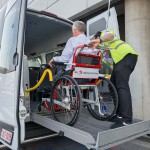- 20 July 2017
- News
- Posted by Admin
- No comments yet
- 20 July 2017
- News
- Posted by Admin
- No comments yet
In cooperation with Ford, Tribus will develop the first Transit where the sliding door entrance will be replaced by a lowered passenger entry step at the co-driver’s door.
This adaptation makes the Ford Transit much more attractive for public transport services. The absence of the sliding door – in combination with a wheelchair lift at the rear – creates a more versatile vehicle for wheelchair accessible passenger transport, as it is now possible to position a wheelchair adjacent to the former sliding door. Converters like Tribus will now be able to create a maximum of four wheelchair areas.
An additional advantage of this adaptation is the fact that passengers can now enter the vehicle face-to-face with the driver, which is – in the Netherlands at least – very much appreciated by passengers and drivers alike.
TriflexAIR
The conversion of the new Ford Transit to a wheelchair accessible minibus with our TriflexAIR wheelchair restraint system
- 20 July 2017
- News
- Posted by Admin
- No comments yet
The TriflexAIR seat, which already complies to the EU and UN regulations in safety belt anchorage (Regulation 14), now also meets the U.S. safety standards for motor vehicles (FMVSS).
In March, the safety belt anchorage of the TriflexAIR seat was subjected to a pull test in accordance with the standards of the FMVSS. Although FMVSS and the EU/UN safety standards are at the same level, the tests are somewhat different. The required test load applied to the safety belt is slightly higher in R 14 testing, but the FMSVV requires a longer test duration.
The TriflexAIR seat passed the test well beyond the minimum requirements. This means that it is now possible to use the seat in vehicles registered in the U.S. or in other countries which conform to the FMVSS, although bodybuilders should test the seats additionally to get their vehicles approved.
The lightweight construction and slim design has attracted much attention since the
- 20 July 2017
- Customers, News
- Posted by Admin
- No comments yet
- 16 January 2017
- News
- Posted by Admin
- Comments Off on Civitas also available with electromagnetic retarders
The Civitas, our low-floor minibus, is also available with electromagnetic retarders. The retarder dissipates a large part of the braking energy, thus relieving the default breaking system. Retarders are therefore often a criterion for public transport tenders in hilly environments. Besides safety concerns, retarders also extend the lifespan of the default braking system.
In our Civitas, the retarders are fully integrated with the default braking system. The retarder enters into force when the footbrake is used, but it can also be operated independently by a lever near the steering wheel. The retarder is also compatible with the anti-skid braking system (ABS) of the Civitas.
The retarder consists of a casing with several electromagnetic coils. On both sides the retarder is joined with the drive shaft.
- 27 December 2016
- News
- Posted by Admin
- No comments yet
Recently, the Dutch province North Holland took into use 14 Civitas Economy’s. The low floor minibuses will operate as so-called “neighbourhood busses”. Neighbourhood busses are bus services run by local volunteer associations in areas with low population density where (semi-)commercial exploitation of public transport services is not viable.
The Civitas Economy is specifically designed for services like this. The bus combines a Mercedes-Benz Sprinter with an easily accessible interior. With its semi low floor, its wide sliding doors, spacious seat layout and a fully equipped drivers’ cabin, the Civitas Economy is a surprisingly comfortable vehicle for both passengers and driver.
Although the busses will be operated by the neighbourhood associations, the bus services are integrated in the timetables of Connexxion, one of the major public transport companies in the Netherlands and the current concessionaire in North Holland . Currently, North Holland has 18 neighbourhood buses, run by a total of ten volunteer associations. Last year,
- 23 December 2016
- Customers, News
- Posted by Admin
- Comments Off on Hendriks convert their own minibuses








